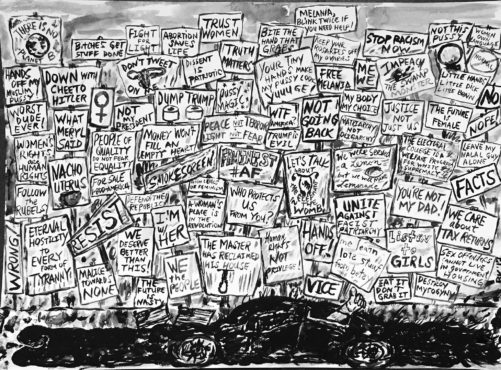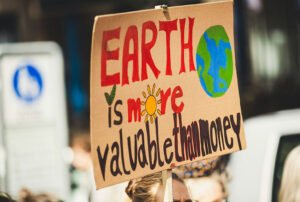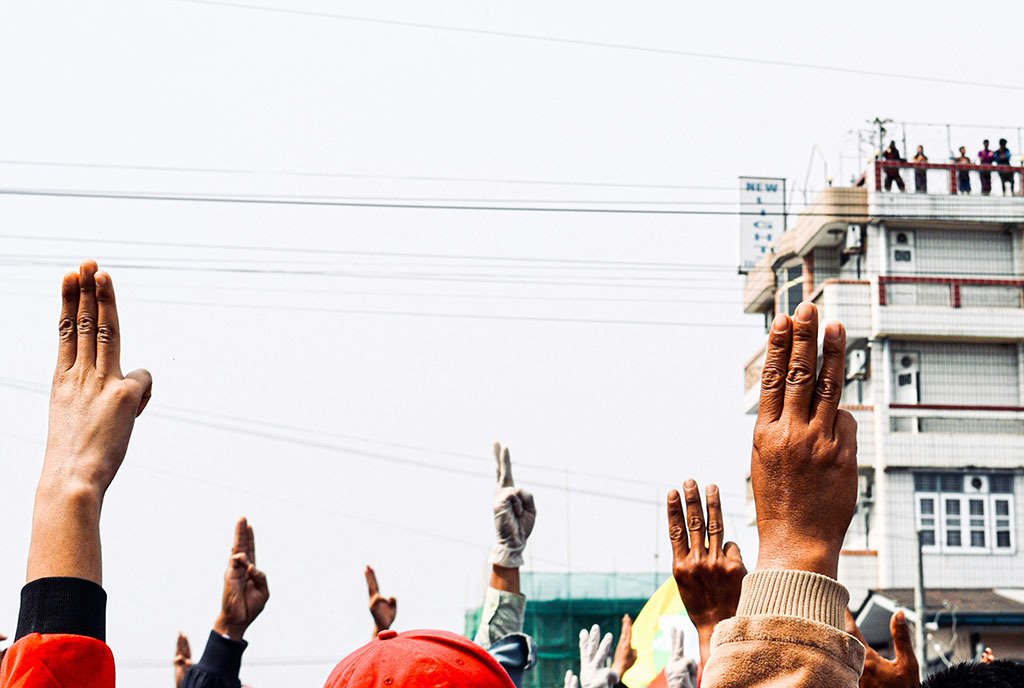
Anyone who participated in the Women’s March on Washington on January 21st is still feeling the aftereffects even as the first few days of the new administration have confirmed the need for a healthy and energetic resistance movement. How do we carry the remarkable showing of energy at those historic marches forward? I offer this reflection as a contribution to learning while building a movement that has enormous implications for the future of the planet.
One of the questions seen over and over again from those who didn’t march, or questioned the legitimacy of the march, was “Why? What was the point?” As one Facebook poster put it the day after the march, “What exactly was this for? The vulgar signs and Hollywood narcissists turned me off. The peaceful message lost—what exactly were they protesting?”
Indeed, many who participated have been asking themselves some version of that same question—not with cynicism, but rather with an attempt to synthesize in a real and personal way what their participation signified and to think about next steps.
Sarah Brown, writing in Vogue, said she went to be counted, “to be a speck amongst hundreds of thousands of other specks who cared enough to show up to say, I do not agree.”
Dayle A. Brenner, a licensed clinical social worker (LCSW-R) who marched in New York City, called it “one of the most extraordinary days of my life,” despite experiencing anxiety from the large crowd congestion. “I have felt so isolated since the election because I couldn’t get over my shock—particularly in regard to the large percentage of women who voted for [Donald Trump]. The passion, commiseration, commitment and cordiality of the day turned my entire perspective around 180 degrees.” She noted that her favorite speeches were those she watched on YouTube: Michael Moore and Scarlet Johansson in D.C., as well as Elizabeth Warren in Boston.
A young woman who preferred not to be named, a professional in the sciences who marched in South Carolina, also watched several of the D.C. speeches online. “I think some of the celebrities hit the nail on the head and are using their voice and privilege to express what many women are feeling. Alicia Keys’ and Ashley Judd’s speeches were incredible in my opinion. And while I was a little disappointed that we only had a rally in my city, it was very inspiring to me to hear all of our speakers, including a woman from our city council.”
Suzanne McBride-Pezzullo, a retired teacher, however, said, “I’m not keeping track of what the celebs are saying. I’m more interested in what young women like my own daughter are demanding. A voice. Equal pay. The same rights as men. Funding continuation for breast cancer research and other woman’s health issues.”
Jane Gerhard is a New York City human resources executive who marched in D.C. She said the overarching reason she participated was in support of civil rights. Her fear is that “what we’re seeing in just this short time is only the beginning, and that things are going to get much worse.” But what helped was “the feeling of sister (and brother) hood displayed throughout the march.” She asked, “How can we bottle that sense of community and keep it going?”
When asked about the organization of the event itself, Gerhard said she had hoped the message would be simple and clear. “But then maybe fewer people would have shown up.” While acknowledging the challenges of organizing 500,000 people, she nonetheless noted that “it would have been more enjoyable if the presenters and organizers knew what was happening in the crowds.”
Indeed, with several hundred thousand more marchers swelling the streets in DC than were expected, it’s impressive that the day progressed, all in all, peacefully and without incident. In a piece written for New York Magazine before the march, Rebecca Traister quotes Linda Sarsour, a Muslim activist who was one of the four national co-chairs: Very soon after the march was announced, “logistics became the main focus,” she said. “As if women were not sophisticated enough to know how to obtain permits. I was like, ‘Can someone ask me about my principles and values?’”
But to seasoned veterans of advocacy movements, those questions are not mutually exclusive and, as is the case with any monumental movement of this nature, there are important organizational lessons to be absorbed.
Kim Otis lives in D.C. and, standing at 4th St and Independence Avenue, was close enough to hear some of the speeches. She is Director of Advancement at Women for Afghan Women (WAW) and has spent her career building effective organizations for women’s human rights and social justice. That day, she was responsible for hosting a large group of women who had taken a bus in from WAW’s community center in Queens. She spoke about her experience:
Sign up for our free newsletters
Subscribe to NPQ's newsletters to have our top stories delivered directly to your inbox.
By signing up, you agree to our privacy policy and terms of use, and to receive messages from NPQ and our partners.
“My group was frustrated and everyone around was chanting ‘Let us march.’ There were too many speeches, and some were good—the WAW women recognized and loved March organizer Linda Sarsour’s voice. Personally, I loved Gloria Steinem’s speech the most, but many were not inspired.”
As to the mechanics of the march, despite the fact that peace reigned throughout—a near miracle in a demonstration of this size—Otis felt they could have been better. She attributes part of the problem to the fact that there were not many D.C. organizers in the leadership with connections to the city’s leaders, and police, sanitation and transportation departments. She quoted her sister, who pointed out that “marathons are run much more efficiently all over the country.” Yet, in spite of the mounting frustration, repeated chants from the crowd to stop talking and start walking, and the fact that speakers were still queuing up on the stages more than a full hour and a half after the march was scheduled to begin, everyone remained peaceful, and organized calm prevailed—a testament to those who participated.
The program, too, though inspiring to many who—from the comfort of their home computers—could cherry-pick the best speeches, needed to be better curated and edited down, according to some participants. Karen Hessel, retired program director for Justice for Women at the National Council of Churches, wrote her own analysis of the speakers, first focusing on what she called Madonna’s “f-bomb” speech:
We listened twice, and it was rambling and rather self-indulgent. Gloria, Cecile, Angela, America did very well because they were prepared and succinct. Too many others were redundant, and need serious training in public speaking. It does them and their organizations a disservice. And I think being there is different because you can’t really see and hear everything and the crowd’s energy is so wonderful, but on C-SPAN last night it was pretty tiresome. But overall, it’s wonderful that it all went as well as it did.
People will be processing the aftereffects of the march in the days and weeks to come, and weighing in on whether—and how—the feel-good energy of more than a million people mobilizing across the globe gets translated into advocacy.
As Ruth McCambridge and Anna Berry point out here, the march is just what it seemed: “A coming-out for those who are ready to mobilize against some of the directions in which the Trump administration is headed. How that mobilization will occur, how it will grow, in what forms, and with what momentum are hard to say, but if the sheer numbers are any indication, the next five years will not be passive for civil society organizers.”
Unlike the civil rights and anti-Vietnam War movements of the Civil Rights Era, observers note, rightly, that there was no common, connecting theme to the march. This is no accident, and moreover, issues of inclusiveness and intersectionality were widely brought in from the very beginning, as detractors mocked them as part of a PC “torture chamber” and organizers continue to ask themselves how large the tent will be. As Clara Antonia Reyes, a manager for an educational nonprofit (who chose not to march) put it, “Now that it’s over, I’ve begun to think about how I, as a woman of color, can begin to take actions to shift the views of the white women I work with to make them see that it is now time to give women of color the platform to be activists, and for them to step aside to allow that to happen.”
To many women who attended, the need for unity and clearer messaging is apparent. Barbara Biesenbach Spitzer, a business consultant who participated in the D.C. march, thinks more concrete themes will ultimately need to emerge. “Many laughed at Occupy Wall Street because they never really got a crisp message in place.”
But Women for Afghan Women’s Otis says, “For me, the beauty of the March was its embrace of all progressive issues as women’s issues. Looking ahead, we plan on doing much more advocacy here in DC with members of Congress for women’s rights. We’re interviewing for a new advocacy manager and there are lots of future actions planned.” She reiterated how meaningful the march was to the organization. “WAW’s women were so proud to be there and are now actively engaging with coalitions to address anticipated executive orders banning refugees and immigrants from certain Muslim countries and eliminating the Office of Violence Against Women at the Department of Justice.”
As of this writing, there are now plans in place for a Science March on Washington. We will be covering this as the organization of that event unfolds.
As someone who participated in the D.C. march and has been processing the experience in the days following, it’s the opinion of this writer that, as activists and NGOs, we should concentrate on continuing the work in the space in which we find ourselves, be it the environment, education, the arts or arms control. What is paramount right now is—as the tech community is so fond of saying (and I’m paraphrasing)—how we get “stuff” done.
There are certain strategies and principles that transcend identity and issue politics that we can all commit to so that, whether we are working on X, Y or Z, the approach is laser-sharp in its focus. Here, therefore, are some suggestions for “getting stuff done.”
- Hound your U.S. legislators. Shortly after the march, organizers published “10 Actions for the First 100 Days” to mobilize participants, the first of which is sending branded postcards to elected officials on specific issues and tying these actions to social media. Good advice. But instead of “pouring your heart out on any issue you care about,” link your phone calls (which are always preferred) or letters with specific laws or actions—find out which bills are in committee and which are coming up for votes. (And make sure you know the names and bill numbers of those bills.)
- Get local. The old adage, “think global, act local” couldn’t be more true today. People start entering politics through school boards, town or village boards, and citizen action committees. Know where your local lawmakers stand and, if their values align with yours, do what you can to support them. If not, run against them. It’s not that far a stretch from mayor to the executive branch (think Wasilla) and, remember, it’s the folks on the school board who will determine whether your kids get taught evolution or “intelligent design.”
- State politics are critical too, whether it’s education, housing, environmental or health care policy. In addition to letting them know where you stand on issues, the men and women in your state house often have money available to support your nonprofit efforts. Their offices are always open and the squeaky wheel really does get the grease.
- Participate in conference calls and webinars when they’re offered by groups that resonate with you. These are good opportunities to listen in on upcoming strategies among activists and learn what everyone can do to support their efforts. For example, Fwd.us is one NGO working for comprehensive immigration reform that hosts regular conference updates.
- Volunteer, donate, host events, and campaign with local NGOs and charities. Whatever your passion, there’s an organization for that.
- Try, wherever possible, to present a united front. While financials, programs and activities should remain completely and 100% transparent, as an old Irish woman I knew used to say, “not everyone needs to know your business.” Keep the mission front and center and keep the squabbles and inside baseball inside the organization and work it out amongst yourselves.
- Remember, it’s not just the Supreme Court that matters. Informed citizens need to pay attention to their state and local courts, too. The Leadership Conference hosts an excellent website where you can learn more about this most misunderstood of the three branches of government, as does the National Constitution Center.
- Be respectful. Don’t get bogged down in the trivial. As fun as it may be to speculate what the new first lady is thinking as she stands next to her husband, these kinds of things are a distraction. Don’t post or share negative memes. Remember what the Obamas suffered through for eight years. We all have neighbors, friends, and relatives who voted for the new administration. No one is going to be turned around by a mean-spirited meme. Don’t be ugly or hateful and don’t give people ammunition to use against your organization or cause. And, as a writer on Saturday Night Live recently learned, kids are off-limits. Enough said.
- Be dignified yet creative, and value quality over quantity in oration. We need to consider the valuable role of curation from the podium in events like this going forward. They represent important opportunities to inspire and attract and engage both on site and from afar.
- Finally, for NGO leaders, defend your ground. There is a lot of bad information making the rounds about nonprofits, and some or all are likely to be targeted under this new administration. As a group, the NGO community needs to stand ready to push back on issues of image and role of our critical sector and the nonprofits that represent, in many cases, the ground floor of social activism.













